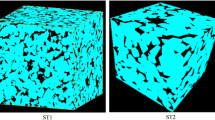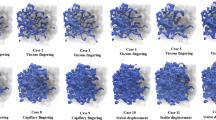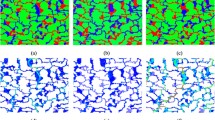Abstract
We investigated the interfacial tension (IFT) effect on fluid flow characteristics inside micro-scale, porous media by a highly efficient multi-phase lattice Boltzmann method using a graphics processing unit. IFT is one of the most important parameters for carbon capture and storage and enhanced oil recovery. Rock pores of Berea sandstone were reconstructed from micro-CT scanned images, and multi-phase flows were simulated for the digital rock model at extremely high resolution (3.2 \(\upmu \)m). Under different IFT conditions, numerical analyses were carried out first to investigate the variation in relative permeability, and then to clarify evolution of the saturation distribution of injected fluid. We confirmed that the relative permeability decreases with increasing IFT due to growing capillary trapping intensity. It was also observed that with certain pressure gradient \(\Delta P\) two crucial IFT values, \(\sigma _{1}\) and \(\sigma _{2}\), exist, creating three zones in which the displacement process has totally different characteristics. When \(\sigma _{1}< \sigma < \sigma _{2}\), the capillary fingering patterns are observed, while for \(\sigma < \sigma _{1}\) viscous fingering is dominant and most of the passable pore spaces were invaded. When \(\sigma > \sigma _{2}\) the invading fluid failed to break through. The pore-throat-size distribution estimated from these crucial IFT values (\(\sigma _{1 }\)and \(\sigma _{2})\) agrees with that derived from mercury porosimetry measurements of Berea sandstone. This study demonstrates that the proposed numerical method is an efficient tool for investigating hydrological properties from pore structures.


















Similar content being viewed by others
References
Ahrenholz, B., Tölke, J., Lehmann, P., Peters, A., Kaestner, A., Krafczyk, M., Durner, W.: Prediction of capillary hysteresis in a porous material using lattice-Boltzmann methods and comparison to experimental data and a morphological pore network model. Adv. Water Resour. 31(9), 1151–1173 (2008)
Aidun, C.K., Clausen, J.R.: Lattice-Boltzmann method for complex flows. Annu. Rev. Fluid Mech. 42, 439–472 (2010)
Asar, H., Handy, L.: Influence of interfacial tension on gas/oil relative permeability in a gas-condensate system. SPE Reserv. Eng. 3(1), 257–264 (1988)
Bachu, S., Gunter, W.D., Perkins, E.H.: Aquifer disposal of CO\(_{2}\): hydrodynamic and mineral trapping. Energy Convers. Manag. 35(4), 269–279 (1994)
Badalassi, V.E., Ceniceros, H.D., Banerjee, S.: Computation of multiphase systems with phase field models. J. Comput. Phys. 190(2), 371–397 (2003)
Bailey, P., Myre, J., Walsh, S.D.C., Lilja, D.J., Saar, M.O.: Accelerating lattice Boltzmann fluid flow simulations using graphics processors. In: Proceedings of the 2009 International Conference on Parallel Processing, Vienna, Austria, 2009, pp. 550–557
Bardon, C., Longeron, D.G.: Influence of very low interfacial tensions on relative permeability. Soc. Pet. Eng. J. 20(5), 391–401 (1980)
Bear, J.: Dyn. Fluids Porous Media. Elsevier Science, New York (1972)
Boek, E.S., Venturoli, M.: Lattice-Boltzmann studies of fluid flow in porous media with realistic rock geometries. Comput. Math. Appl. 59, 2305–2314 (2010)
Chen, Q., Gingras, M.K., Balcom, B.J.: A magnetic resonance study of pore filling processes during spontaneous imbibition in Berea sandstone. J. Chem. Phys. 119(18), 9609–9616 (2003)
Cuda programming guide 5.0 (2012). http://docs.nvidia.com/cuda/index.html. Accessed 7 Dec 2012
d’Humieres, D.: Generalized lattice Boltzmann equations. Rarefied gas dynamics: theory and simulations. Prog. Astronaut. Aeronaut. 159, 450–458 (1992)
Fulcher Jr, R.A., Ertekin, T., Stahl, C.D.: Effect of capillary number and its constituents on two-phase relative permeability curves. J. Pet. Technol. 37(2), 249–260 (1985)
Ginzburg, I., Verhaeghe, F., d’Humieres, D.: Two-relaxation-time lattice Boltzmann scheme: about parameterization, velocity, pressure and mixed boundary conditions. Commun. Comput. Phys. 3, 427–478 (2008)
Goldsmith, H.L., Mason, S.G.: The flow of suspensions thorough tubes: II. Single large bubbles. J. Colloid Interface Sci. 18, 237–261 (1963)
Gunstensen, A., Rothman, D., Zaleski, S., Zanetti, G.: Lattice Boltzmann model of immiscible fluids. Phys. Rev. A 43, 4320–4327 (1991)
Hirt, C.W., Nichols, B.D.: Volume of fluid (VOF) method for the dynamics of free boundaries. J. Comput. Phys. 39(1), 201–225 (1981)
Kandhai, D., Koponen, A., Hoekstra, A.G., Katajam, M., Timonen, J., Sloot, P.M.A.: Lattice-Boltzmann hydrodynamics on parallel systems. Comput. Phys. Commun. 111(1–3), 14–26 (1998)
Kehrwald, D.: Numerical analysis of immiscible lattice BGK. Ph.D. thesis, Universitat Kaiserslautern (2003)
Kuznik, F., Obrecht, C., Rusaouen, G., Roux, J.J.: LBM based flow simulation using GPU computing processor. Comput. Math. Appl. 59(7), 2380–2392 (2010)
Lallemand, P., Luo, L.: Theory of the lattice Boltzmann method: dispersion, dissipation, isotropy, Galilean invariance, and stability. Phys. Rev. E 61, 6546–6562 (2000)
Latva-Kokko, M., Rothman, D.H.: Static contact angle in lattice Boltzmann models of immiscible fluids. Phys. Rev. E 72, 046701 (2005)
Lenormand, R., Zarcone, C.: Capillary fingering: percolation and fractal dimension. Transp. Porous Media 4, 599–612 (1989)
Metz, B., et al. (eds.): IPCC Special Report, Carbon Dioxide Capture and Storage. Cambridge University Press, Cambridge (2005)
Michael, K., Golab, A., Shulakova, V., Ennis-King, J., Allinson, G., Sharma, S., Aiken, T.: Geological storage of CO\(_{2}\) in saline aquifers—a review of the experience from existing storage operations. Int. J. Greenh. Gas Control 4(4), 659–667 (2010)
Miller, C.T., Christakos, G., Imhoff, P.T., McBride, J.F., Pedit, J.A., Trangenstein, J.A.: Multiphase flow and transport modeling in heterogeneous porous media: challenges and approaches. Adv. Water Res. 21(2), 77–120 (1998)
Obrecht, C., Kuznik, F., Tourancheau, B., Roux, J.J.: A new approach to the lattice Boltzmann method for graphics processing units. Comput. Math. Appl. 61(12), 3628–3638 (2011)
Øren, P.E., Bakke, S.: Reconstruction of Berea sandstone and pore-scale modelling of wettability effects. J. Pet. Sci. Eng. 39(3–4), 177–199 (2003)
Pan, C., Hilpert, M., Miller, C.T.: Lattice Boltzmann simulation of two-phase flow in porous media. Water Res. Res. 40(1) (2004)
Pan, C., Luo, L.S., Miller, C.T.: An evaluation of lattice Boltzmann schemes for porous medium flow simulation. Comput. Fluids 35, 898–909 (2006)
Ramstad, T., Idowu, N., Nardi, C., Øren, P.E.: Relative permeability calculations from two-phase flow simulations directly on digital images of porous rocks. Transp. Porous Media 94(2), 487–504 (2012)
Shan, X., Chen, H.: Lattice Boltzmann model for simulating flows with multiple phases and components. Phys. Rev. E 47, 1815–1819 (1993)
Sussman, M., Almgren, A.S., Bell, J.B., Colella, P., Howell, L.H., Welcome, M.L.: An adaptive level set approach for incompressible two-phase flows. J. Comput. Phys. 148(1), 81–124 (1999)
Swift, M., Orlandini, E., Osborn, W., Yeomans, J.: Lattice Boltzmann simulations of liquid-gas and binary fluid systems. Phys. Rev. E 54, 5041–5052 (1996)
Talash, A.W.: Experimental and calculated relative permeability data for systems containing tension additives. Soc. Pet. Eng. J. 1976, 177–188 (1976)
Toelke, J., Krafczyk, M., Schulz, M., Rank, E.: Lattice Boltzmann simulations of binary fluid flow through porous media. Philos. Trans. R. Soci. Lond. A 360, 535–545 (2002)
Toelke, J., Freudiger, S., Krafczyk, M.: An adaptive scheme using hierarchical grids for lattice Boltzmann multi-phase flow simulations. Comput. Fluid 35, 820–830 (2006)
Tölke, J., Krafczyk, M.: TeraFLOP computing on a desktop PC with GPUs for 3D CFD. Int. J. Comput. Fluid Dyn. 22(7), 443–456 (2008)
Tölke, J.: Implementation of a lattice Boltzmann kernel using the compute unified device architecture developed by nVIDIA. Comput. Vis. Sci. 13(1), 29–39 (2010)
Wang, X., Aoki, T.: Multi-GPU performance of incompressible flow computation by lattice Boltzmann method on GPU cluster. Parallel Comput. 37(9), 521–535 (2011)
Yang, J., Boek, E.S.: A comparison study of multi-component lattice Boltzmann models for flow in porous media applications. Comput. Math. Appl. 65(6), 882–890 (2013)
Acknowledgments
We gratefully acknowledge the support of the I2CNER, which is sponsored by the World Premier International Research Center Initiative (WPI), Ministry of Education, Culture, Sports, Science, and Technology (MEXT), Japan. This work was supported by the grant for Environmental Research Projects facility of The Sumitomo Foundation and partially supported by a grant from the Grant-in-Aid for Challenging Exploratory Research facility of MEXT (No. 24656536).
Author information
Authors and Affiliations
Corresponding author
Electronic supplementary material
Below is the link to the electronic supplementary material.
Supplementary material 1 (avi 46979 KB)
Appendix 1: Multi-phase Lattice Boltzmann Model
Appendix 1: Multi-phase Lattice Boltzmann Model
A D3Q19 (19 velocity vectors in 3D) lattice model is adopted, in which the 19 microscopic velocities are sorted in antiparallel pairs for the convenience of the anti-diffusion recoloring algorithm described later (Toelke et al. 2002). A brief description follows.
The multi-relaxation time collision operator (d’Humieres 1992) incorporating the effects of surface tension was used here to enhance stability. The local propagation and collision process of the fluid particle distribution can be described by:
where \(\delta t\) is the time step and \(f_i ( {\mathbf{{x}},t})\) is the particle distribution function that represents the probability of finding a particle at node x and time t with velocity \(\mathbf{{e}}_i \). The microscopic velocities are given with
where c is a constant lattice reference velocity. The collision operator of the multiple-relaxation-time model is given by
where \(\mathbf{M}\) is the transformation matrix given in Toelke et al. (2006), which transforms the distributions into moment space. The resulting moments \(\mathbf{m}=\mathbf{M}f\) are written as
where \(\delta \rho \) is the density variation, \(\mathbf{j}=\rho _0 \left( {u_x ,u_y ,u_z } \right) \) is the momentum and \(\rho _0 \) is the constant reference density. The moments \(e,p_{xx} ,p_{ww} ,p_{xz} ,p_{yz} ,p_{xz} \) of the second order are related to the strain rate tensor. The moments of higher order are involved in higher order derivatives of the flow field and their effect can be ignored. The equilibrium vector \(\mathbf{m}^\mathrm{{eq}}\) is composed of equilibrium moments, which can be found in Toelke et al. (2006). During the collision, the moments {\(m_k \), \(k\) = 0, 3, 5, 7} are always conserved, leading to mass and momentum conservation of this algorithm. The macroscopic quantities density and momentum are given by
The matrix \(\mathbf {S}\) is a diagonal collision matrix indicating the relaxation rates which related to the kinematic viscosity. The non-zero collision parameters \(S_{i,i} \) (the eigenvalues of the collision matrix \(\mathbf{M}^{-1}\mathbf{SM})\) are

The relaxation rate \(s_\nu \) is related to the kinematic viscosity \(\nu \) by
The other parameters \(s_e \),\(s_\xi \), \(s_q \), \(s_\pi \), and \(s_m \) have to be chosen in the range [0,2] and can be tuned to improve accuracy and stability. The optimal choice of these parameters can be referred to Ginzburg and Verhaeghe (2008).
A phase-field approach is introduced to treat the two-phase flow. A order parameter \(\phi \) is defined by using fluid densities field of wetting phase \(\rho _w \) and non-wetting phase\(\rho _n \) as
The value of \(\phi \) is constant in the bulk of each fluid phase and varies in the range [\(-1\),1] at the diffusive fluid–fluid interface. The width of the interface is around 2–3 lattice units, which is smaller than other multi-component LB models (Yang and Boek 2013). The gradient of \(\phi \) in lattice framework is calculated as
The normalized gradient is
which defines the orientation of the interface. The advection of a scalar density field \(\psi \), (\(\psi =\rho _\mathrm{{w}} or \rho _\mathrm{{n}} )\), can be done by using the following LB equation for dimensionless density distribution \(g_i \):
The equilibrium distribution function is given by
The velocity u is computed by the flow solver described above. The weight coefficients are
The LB Eqs. (23) and (24) result in an advection–diffusion equation solver (Kehrwald 2003), in which the diffusion coefficient is \(\alpha =\left( {1/6} \right) c^{2}\delta t\). This diffusion coefficient is usually undesirable for immiscible fluids, therefore a recoloring algorithm is applied to cancel out the diffusion effect and keep the interface sharp. In the recoloring step, we redistribute the mass distributions of \(\rho _\mathrm{{w}} \) and \(\rho _\mathrm{{n}} \) in a way that the inner product of the gradient C and the momentum of phase \(\rho _\mathrm{{w}} \) is maximized. Two physical constraints have to be considered in this algorithm: the conservation of the mass of each phase and the conservation of the momentum of the sum of both phases. The detail recoloring algorithm used here can be found in Toelke et al. (2002).
Generation of IFT is realized by modifying the equilibrium equations in the vicinity of the interface that introducing a perturbation based on the gradient of the phase field. These additional contributions of the interface to the equilibrium moments \({{\varvec{m}}}^{eq}\) are
where \(\sigma \) is the surface tension, \(n_{x,y,z}\) is the normalized gradient given in (Eq. 22), \(m_1^{\mathrm{{in}}} \) represents the interfacial effect to the moment which corresponds to the microscopic kinetic energy, and \(m_9^{\mathrm{{in}}}, m_{11}^{\mathrm{{in}}}, m_{13}^{\mathrm{{in}}}, m_{14}^{\mathrm{{in}}}, m_{15}^{\mathrm{{in}}}\) denote the interfacial effect to the seconder order moments related to the viscous stress tensor. By the moment method with the additional terms for treating the interface with surface tension, the numerical stability is improved significantly.
Rights and permissions
About this article
Cite this article
Jiang, F., Tsuji, T. & Hu, C. Elucidating the Role of Interfacial Tension for Hydrological Properties of Two-Phase Flow in Natural Sandstone by an Improved Lattice Boltzmann Method. Transp Porous Med 104, 205–229 (2014). https://doi.org/10.1007/s11242-014-0329-0
Received:
Accepted:
Published:
Issue Date:
DOI: https://doi.org/10.1007/s11242-014-0329-0




